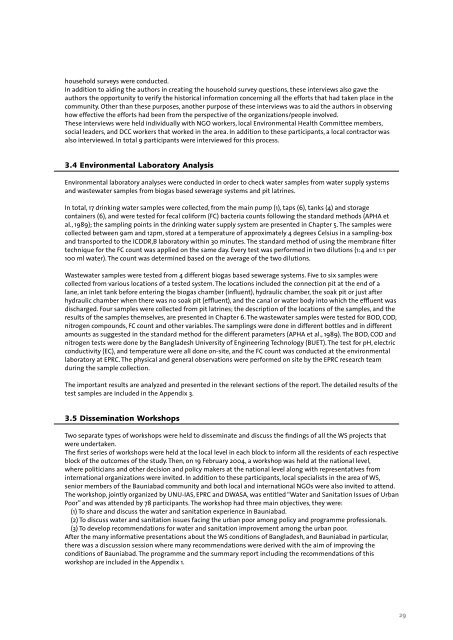Untitled - UNU-IAS - United Nations University
Untitled - UNU-IAS - United Nations University
Untitled - UNU-IAS - United Nations University
You also want an ePaper? Increase the reach of your titles
YUMPU automatically turns print PDFs into web optimized ePapers that Google loves.
household surveys were conducted.<br />
In addition to aiding the authors in creating the household survey questions, these interviews also gave the<br />
authors the opportunity to verify the historical information concerning all the efforts that had taken place in the<br />
community. Other than these purposes, another purpose of these interviews was to aid the authors in observing<br />
how effective the efforts had been from the perspective of the organizations/people involved.<br />
These interviews were held individually with NGO workers, local Environmental Health Committee members,<br />
social leaders, and DCC workers that worked in the area. In addition to these participants, a local contractor was<br />
also interviewed. In total 9 participants were interviewed for this process.<br />
3.4 Environmental Laboratory Analysis<br />
Environmental laboratory analyses were conducted in order to check water samples from water supply systems<br />
and wastewater samples from biogas based sewerage systems and pit latrines.<br />
In total, 17 drinking water samples were collected, from the main pump (1), taps (6), tanks (4) and storage<br />
containers (6), and were tested for fecal coliform (FC) bacteria counts following the standard methods (APHA et<br />
al., 1989); the sampling points in the drinking water supply system are presented in Chapter 5. The samples were<br />
collected between 9am and 12pm, stored at a temperature of approximately 4 degrees Celsius in a sampling-box<br />
and transported to the ICDDR,B laboratory within 30 minutes. The standard method of using the membrane filter<br />
technique for the FC count was applied on the same day. Every test was performed in two dilutions (1:4 and 1:1 per<br />
100 ml water). The count was determined based on the average of the two dilutions.<br />
Wastewater samples were tested from 4 different biogas based sewerage systems. Five to six samples were<br />
collected from various locations of a tested system. The locations included the connection pit at the end of a<br />
lane, an inlet tank before entering the biogas chamber (influent), hydraulic chamber, the soak pit or just after<br />
hydraulic chamber when there was no soak pit (effluent), and the canal or water body into which the effluent was<br />
discharged. Four samples were collected from pit latrines; the description of the locations of the samples, and the<br />
results of the samples themselves, are presented in Chapter 6. The wastewater samples were tested for BOD, COD,<br />
nitrogen compounds, FC count and other variables. The samplings were done in different bottles and in different<br />
amounts as suggested in the standard method for the different parameters (APHA et al., 1989). The BOD, COD and<br />
nitrogen tests were done by the Bangladesh <strong>University</strong> of Engineering Technology (BUET). The test for pH, electric<br />
conductivity (EC), and temperature were all done on-site, and the FC count was conducted at the environmental<br />
laboratory at EPRC. The physical and general observations were performed on site by the EPRC research team<br />
during the sample collection.<br />
The important results are analyzed and presented in the relevant sections of the report. The detailed results of the<br />
test samples are included in the Appendix 3.<br />
3.5 Dissemination Workshops<br />
Two separate types of workshops were held to disseminate and discuss the findings of all the WS projects that<br />
were undertaken.<br />
The first series of workshops were held at the local level in each block to inform all the residents of each respective<br />
block of the outcomes of the study. Then, on 19 February 2004, a workshop was held at the national level,<br />
where politicians and other decision and policy makers at the national level along with representatives from<br />
international organizations were invited. In addition to these participants, local specialists in the area of WS,<br />
senior members of the Bauniabad community and both local and international NGOs were also invited to attend.<br />
The workshop, jointly organized by <strong>UNU</strong>-<strong>IAS</strong>, EPRC and DWASA, was entitled “Water and Sanitation Issues of Urban<br />
Poor” and was attended by 78 participants. The workshop had three main objectives, they were:<br />
(1) To share and discuss the water and sanitation experience in Bauniabad.<br />
(2) To discuss water and sanitation issues facing the urban poor among policy and programme professionals.<br />
(3) To develop recommendations for water and sanitation improvement among the urban poor.<br />
After the many informative presentations about the WS conditions of Bangladesh, and Bauniabad in particular,<br />
there was a discussion session where many recommendations were derived with the aim of improving the<br />
conditions of Bauniabad. The programme and the summary report including the recommendations of this<br />
workshop are included in the Appendix 1.<br />
29
















